Pink Bush f1 Tomato: High Yield Guaranteed
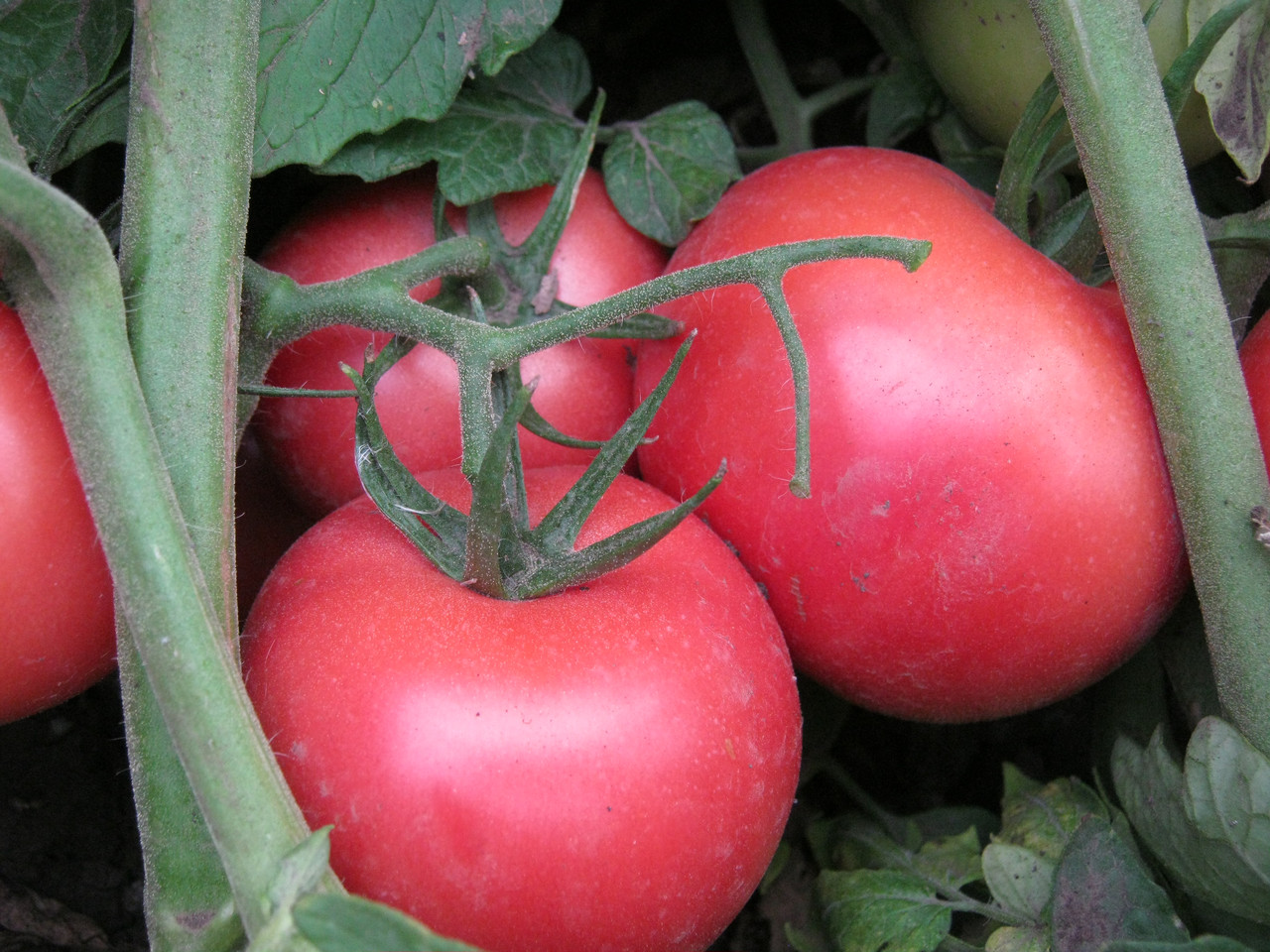
For several years, Japanese pink-fruited hybrids have been popular among summer residents. According to medical scientists, using such tomatoes as food, it is possible to normalize the work of the cardiovascular system, as well as to use them for the prevention of cancer. Pink tomatoes help fight depression and make us happier.
Among Japanese hybrids, the Pink Bush tomato variety stands out for its unpretentiousness. Experts recommend this tomato for growing indoors for most areas of Russia, and only in areas with a warmer climate - in open ground. The variety is early ripe, ripening occurs within 3-3.5 months from the moment of germination, depending on the growing conditions.
Tomato Pink Bush, thanks to these facts, has become increasingly popular with summer residents, for which we give more detailed characteristics and description of the variety.
Description of the bush
Plant determinant type, that is, with a limited point of growth. The maximum height in greenhouses is 75 cm, when grown in open ground up to 50 cm. Shtambovy shrub, with a strong trunk and leaves of deep dark green color. Landings do quite thick - 5-6 bushes per square. meter.
See also: "Abakan pink" handsome red
Fruit characteristics
By the time of ripening, the bushes barely maintain a rich harvest of attractive original fruits, which have the following features:
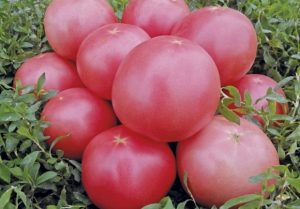
- Fruits of the correct rounded shape, grow by small brushes, the form of the first tomatoes more flat, than at the others.
- The color of ripe fruit is rich bright pink.
- Fruit weight is even, up to 200g.
- The pulp of tomatoes is tender and juicy, with a dry matter content of about 7%, rich in carotene, lycopene, vitamins of group B.
- The surface is smooth, without dents.
- Tomatoes are not prone to cracking.
- They are characterized by high keeping quality and resistance to transportation.
- Fruits taste great, suitable for use in the form of salads and juices, do not lose their properties during heat treatment, are suitable for use in dried form, for preservation in the form of various ketchups and lecho.
Pink Bush’s tomato, according to gardeners, attracts attention not only by the attractive appearance of ripe fruits, which can be noted in the photo, but also by high yields - up to 12 kg per square meter.
Diseases and pests
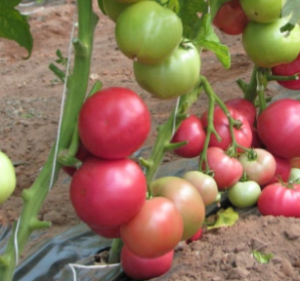 The hybrid is resistant to most viral and fungal diseases of tomatoes. If you follow the rules of agricultural engineering - timely watering, airing greenhouses, loosening the soil, the plants do not get sick, do not need additional treatments with chemicals.
The hybrid is resistant to most viral and fungal diseases of tomatoes. If you follow the rules of agricultural engineering - timely watering, airing greenhouses, loosening the soil, the plants do not get sick, do not need additional treatments with chemicals.
With the main pests - slugs and mites they prefer to fight with folk remedies - an infusion of bitter pepper, mustard, wood ash, irrigation with a solution of soap.
The Colorado potato beetle and slugs are harvested by hand without using chemical agents.
What is this grade good for?
Tomato Pink Bush, if you believe the reviews and photos laid out by those gardeners who planted it in past seasons, attracts the following characteristics:
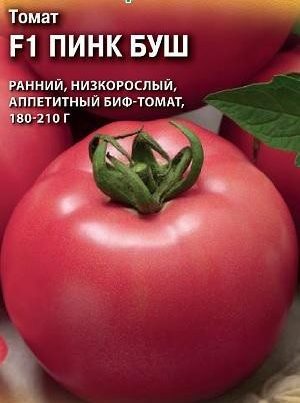
- Fruits have an original bright appearance, do not crack.
- Tomatoes contain many vitamins and other beneficial substances.
- The variety has a high yield, eat fruit with good care reaches 12 kg per square meter. meter
- The hybrid is immune to most fungal diseases.
- It tolerates changes in air temperature and soil moisture.
- Tomatoes retain their properties during storage and transportation for a long time.
- The plant is unpretentious - low strong bushes do not require the formation, thinning, removal of leaves and stepsons.
The disadvantages of varieties usually include the high cost of seeds of the Japanese hybrid. Many growers note the presence on the market of seeds of obvious fakes.
Features of tomato agrotechnics
To obtain a guaranteed harvest of Pink Bush tomatoes, first of all, you need to make sure that the seeds are really from the manufacturer - the Japanese company "Sakata". This manufacturer sells seeds that have undergone pre-treatment, so it is not necessary to soak them in disinfecting solutions and stimulants.
Land for growing seedlings is prepared in the fall. Sod or garden soil is mixed with compost and ash. If the garden soil is heavy and dense, peat or sand is added to it.
To disinfect the soil, you can pre-ignite in the oven or freeze, putting it on the street.
The soil for seedlings should have a light, breathable structure. Sowing time depends on the time of planting in the ground or greenhouse. The age of seedlings at the time of disembarkation is usually 40 - 50 days. Tomatoes should not be allowed to be overgrown, with flowers or even with ovaries. You can get a few early fruits, but in this case you can’t expect a good harvest.
You will be interested in: Growing a tomato according to the method of IM Maslova
Seeds are sown in a well-moistened earth, the distance between them should be at least 2 cm and covered with a small layer of earth (approximately 5 mm), slightly compacting from above. A box with sown seeds is covered with dense material, creating a small greenhouse, and cleaned in a warm place (22-25 degrees).
Further care is to comply with the temperature and light conditions. The temperature in the room during the first days after emergence of shoots is maintained at night 12-13 degrees, in the afternoon 15-16 degrees, with a maximum illumination of at least 10 hours a day. After 7-10 days, the temperature can be increased by 5 degrees. This mode will help to harden the seedlings and at the same time not let it outgrow.
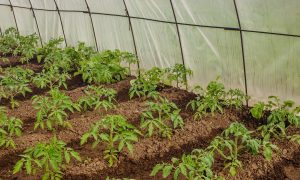 After the appearance of 2-3 true leaves, the plants dive into separate containers or a larger box, thus increasing the distance between them to 20 - 25 cm.
After the appearance of 2-3 true leaves, the plants dive into separate containers or a larger box, thus increasing the distance between them to 20 - 25 cm.
Seedling throughout this period is watered very moderately, the first feeding with mineral fertilizers for seedlings is carried out in a week.
Terms of planting seedlings determines each vegetable grower, depending on the weather conditions in the region. If in the southern regions of Russia and Ukraine, the variety prefer to plant on the beds - in open ground, in areas with cooler summer most of the summer residents use Pink Bush tomatoes for growing in the greenhouse.
The soil for planting plants on the beds and in the greenhouses is prepared in advance, in the autumn they spend its liming, sidderats are planted. The wells for tomatoes are placed at a distance of 40-50cm from one another, compost is introduced into them, mineral fertilizers, ash, they are watered. After that, seedlings are planted and pritenyat, if the day is sunny, with supporting materials.
Subsequent care, both in open ground and protected includes:
- Watering at the root.
- Top dressing by complex mineral fertilizer (3-4 times).
- Loosening and weeding.
- Top dressing with green manure (infusion of rotted grass with a mullein, diluted in water at a ratio of 1:10).
- Control over the appearance of plants.
If you are using a greenhouse for growing a hybrid, you need to pay attention to the following points:
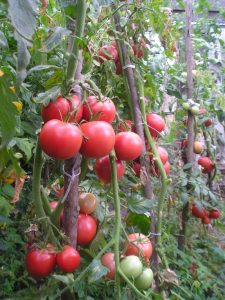
- Tomato does not tolerate high humidity. Therefore, watering is done either under the root, using special containers, or using a device for drip irrigation.
- A good effect for maintaining high soil moisture, while not increasing the humidity of the air, is mulching. As mulch, you can use old cardboard, mowed grass or other auxiliary materials, which also will not allow weeds to grow. The mowed grass, among other things, not only covers the soil, but eventually decomposes and feeds plants with nitrogen.
- Use devices for airing the greenhouse - vents, doors, while it is desirable to avoid drafts.
- Despite the small size of the hybrid in the greenhouse (about 75 cm), the bush needs a garter to the trellis, as the plant can simply break under the weight of the fruit.
A greenhouse gives plants more comfortable growing conditions; therefore, tomatoes here are not only higher and leafy, but also correspondingly more productive. When this occurs, the removal of large amounts of nutrients from the soil.
Observing the plants, you can understand which nutrients they need:

- If the old leaves turn yellow, and the new ones turn off, the plant lacks potassium.
- The plant is drawn out, the leaves turn yellow, the growth slows down with a lack of nitrogen.
- The lack of sulfur is manifested by signs similar to nitrogen starvation, but at the same time young leaves turn yellow.
- With a deficiency of phosphorus leaves get purple hue, twist inside.
- When there is a shortage of copper in the soil, the leaves curl into tubes, the plant sheds flowers, does not form ovaries.
- If the tips of the fruits turn brown and the tomatoes gradually dry up, and the plants stop growing, this is a lack of calcium.
Measures to combat these problems - feeding the relevant trace elements that are present in the market in sufficient quantities.
For several years now, the hybrid has been attracting summer residents with its unpretentiousness and high efficiency of beautiful pink fruits in the southern regions and the middle zone of Russia, Ukraine and Belarus.
It is planted for use, both for personal and commercial purposes - beautiful and tasty fruits always attract buyers and are in demand in the market.
See also: Features growing tomato "Red Guard"
While maintaining warm weather, some growers, competently using greenhouses, manage to harvest a second crop of tomatoes. To this end, after collecting the main crop, the old branches are removed, and the remaining stepchildren have time to get fruit. It is noted that the subsequent crop of tomatoes has time to ripen, although the fruits are smaller in comparison with the first.
Video: Pink Bush Tomato Variety



 (2 ratings, average: 3,50 from 5)
(2 ratings, average: 3,50 from 5)